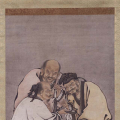Welcome home! Please contact lincoln@icrontic.com if you have any difficulty logging in or using the site. New registrations must be manually approved which may take several days. Can't log in? Try clearing your browser's cookies.
Does anyone know anything about sharpening wood carving tools?
 Jeffrey
Veteran
Jeffrey
Veteran
I found a youtube of a person sharpening these tools with a whetstone which I have. But I tried sharpening and it is still dull. I am going to try again later, but I already tried sharpening for about 10 minutes.
0

Comments
Depending on the tool you are sharpening, you can get a jig to help sharpen it. The jig is a little device that will hold the blade at just the right angle so it is very easy to move it back and forth along the stone at the same angle and pressure. They are quite helpful.
Test out the sharpness of the blade on the back of your fingernail. If it is sharp, the blade will catch on the nail and wont slide across it.
After sharpening for a while, there may be a burr on the blade (a bit of metal that is hanging off to one side). You will need to look closely to see it. Do a final few light passes on each side (with a very fine stone) to get rid of this burr.
Hope this helps.
Happy carving!
What degree angle should I be at?
No.
You need proper whetstones, of different grades.....
And definitely, for curved blades, some kind of jig or implement designed to hold the tool at the correct angle...the angle depends on the tool....
My ex-H had a complete toolkit of carpenter's tools: They had belonged to his Great-grandfather, and although many of the tools were quite worn (Some of the blades had been sharpened down to capacity!) they were all still lethally sharp, because my H had learnt how to keep them in optimum condition, taught by his father, and by his grandfather too...
It takes a lot of practice and patience to get them right....
Now.... if I can just get these blades sharp!
On topic, @federica, what do you suppose the rods are for? Perhaps they ARE for sanding the wood?? I definitely have a regular whetstone, at least, though I don't know relatively how course.
Federica, a curved surface whetsone with a curve matching curve of tool is ideal if reasonably fine, yes. For me, as plebian knife sharpener, I use flat stones and a ceramique rod pair starpening thing-- two ceramique rods, each with artificial diaomond chips embedded in it. Grandpa used a stainless steel sharpening rod on his Solengin steel meat carving knife he passed it on to Dad, who passed it on to the youngest son of the family who was a chef.
@Jeffery, coarser stones will have a look like sandy, not purely in color but in gritinessy look. The finest stones look like real fine sand to powder finer than average sand. Carborundum stones will be grey looking. Carborundum stones are the most common sharpening stones in US now. the finer the stone, the longer it takes to sharpen things with, which is why folks frequently get a coarser whetstone. I am talking grittiness, looks, federica calls this grade or class of fineness of stone, AFAIK.
HTH.
(It won't be near as bad as the first cup I made in pottery class)
hahaha....Who says you need a handle going exactly up and
down? I was never one to conform, anyway...hahaha
Good luck and keep at it!
Does anyone know 'how sharp is sharp'? Like what the tool should be able to do? I am starting on a flat chisels. It is sharp enough to dig right into the flat wood if I am careful, but it just digs a very small amount away. Should I be able to scoop like ice cream? I tried doing a cut with a guiding cut. The guiding cut is 90 degrees into the wood. Then you make a cut and it should stop at the guide. But my chisel I have to put pressure on to cut and it often blazes right through the guiding cut without stopping there.
So the question is 'how sharp is sharp'?
Sharp is is sharp that the cut is deep but for a second or two, you don't even feel pain.
At first.